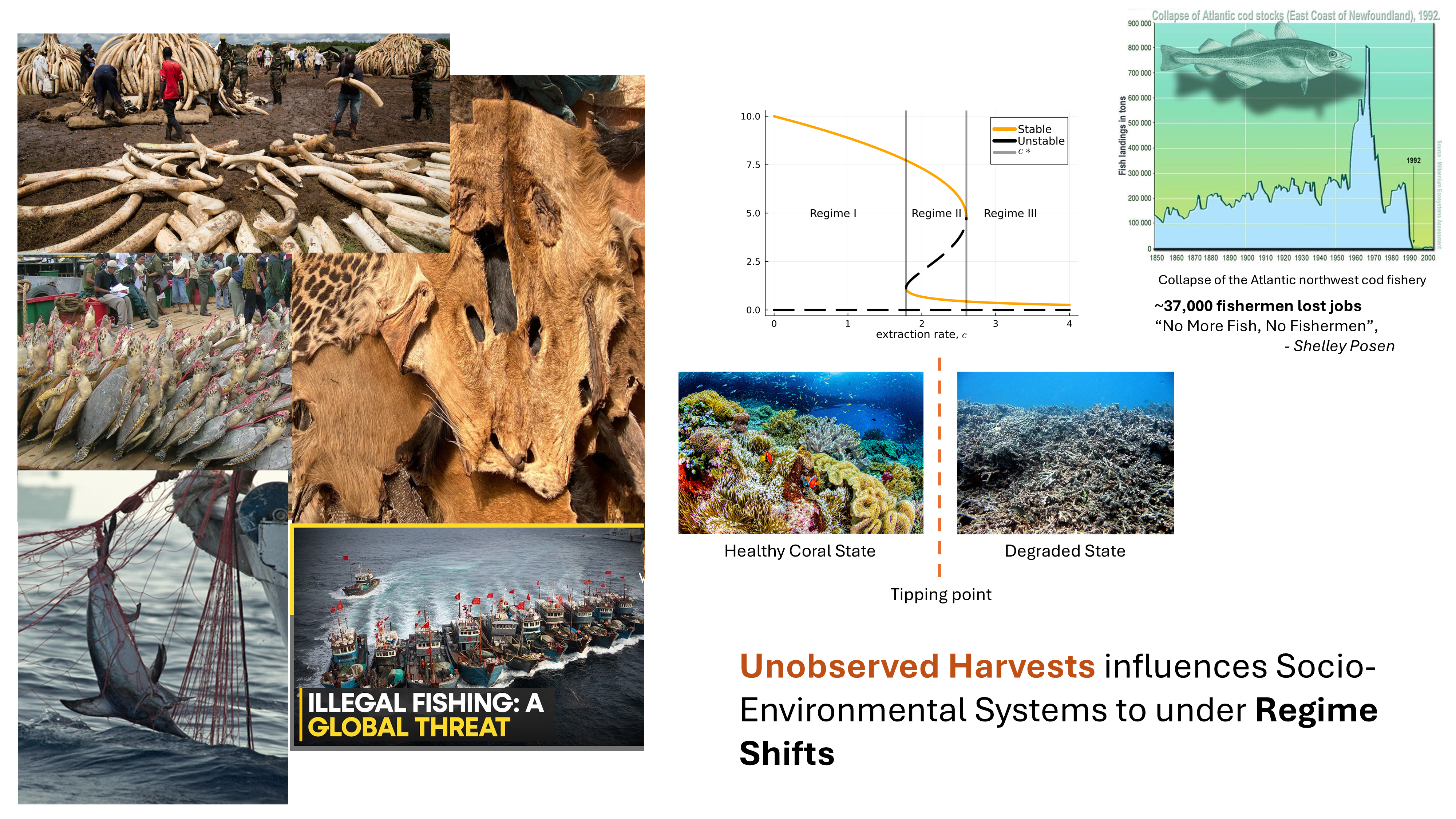C-Star: Predicting unresolved variables in dynamical systems
Published in Oregon State University, 2024

What if we could predict ecosystem collapse before it happens—even when the driving forces remain hidden from view? This research introduces a breakthrough method to identify and forecast regime shifts driven by unobserved factors like illegal poaching or unreported fishing.
The Hidden Threat to Ecosystems
Across the planet, ecosystems are collapsing without warning. Fisheries suddenly crash. Wildlife populations plummet. Forests tip into degraded states. The common thread? We often can’t see what’s driving these catastrophes until it’s too late.
Illegal harvest, unreported poaching, and other hidden extraction activities operate in the shadows—deliberately concealed from monitoring systems. By the time the damage becomes visible in population data, critical thresholds have already been crossed. Traditional forecasting methods fail because they require observing all the important variables. But what if the most important variable is the one you can’t see?
A New Way Forward
This research presents Universal Dynamic Equations (UDEs)—a scientific machine learning framework that can identify hidden drivers of ecosystem collapse from observable data alone. By combining what we know about ecological processes with the pattern-recognition power of neural networks, UDEs can:
- Detect increasing harvest pressure even when it’s completely unreported
- Predict when a system is approaching a dangerous tipping point
- Provide early warnings with less data than conventional methods
- Maintain scientific interpretability while leveraging AI capabilities
The breakthrough: UDEs don’t just forecast what will happen—they reveal why it’s happening by uncovering the hidden parameters pushing systems toward collapse.
Why This Matters Now
Conservation in Crisis
Wildlife managers face an impossible challenge: protecting species when poaching activity is deliberately hidden. Our method offers a path forward—estimating illegal harvest rates from routine population surveys. This means:
- Earlier intervention: Detect threats before populations crash
- Better resource allocation: Direct enforcement where it’s actually needed
- Evidence-based policy: Quantify the true scale of illegal activity
Fisheries on the Brink
Unreported fishing undermines sustainable management worldwide. When catch data is incomplete or fraudulent, quotas become meaningless. UDEs can estimate the real harvest pressure from stock assessments alone, helping prevent the next catastrophic collapse.
Beyond Ecology
The same challenge—critical decisions with hidden driving forces—appears everywhere:
- Climate tipping points: Unobserved feedback loops in Earth systems
- Disease outbreaks: Hidden transmission chains in epidemics
- Economic crises: Latent variables driving market instability
- Infrastructure failure: Unseen degradation processes
Any system where invisible forces drive sudden transitions needs tools that can peer into the darkness.
What Makes This Different
Traditional approaches force an impossible choice:
Mechanistic models capture ecological understanding but require knowing all the parameters—including the hidden ones you’re trying to find.
Data-driven AI can detect patterns but operates as a black box, offering predictions without understanding or trust.
UDEs bridge this divide. They embed neural networks within mechanistic frameworks, preserving interpretability while gaining the flexibility to learn unknown dynamics. The result: predictions you can understand, trust, and act upon.
Key Findings
Testing on a social-ecological system with hidden harvest pressure, UDEs demonstrated:
- Superior accuracy in identifying unobserved parameter changes across all system regimes
- Reliable early warnings of impending regime shifts before critical transitions
- Competitive forecasting with significantly less data than purely statistical methods
- Robust performance even during rapid transitions between stable states
Crucially, the method doesn’t just predict—it reveals the underlying mechanism, showing exactly how hidden extraction is pushing the system toward collapse.
The Bigger Picture
As human pressures intensify globally, ecosystem regime shifts are becoming more common. We’re entering an era where the difference between proactive management and reactive crisis response could determine the fate of entire ecosystems—and the communities that depend on them.
Tools that reveal hidden mechanisms aren’t just academically interesting; they’re essential for effective stewardship in a changing world. When illegal activities threaten ecosystems, or when critical processes remain unobserved, UDEs offer a path to actionable insight.
This isn’t just about better predictions. It’s about seeing the invisible forces that shape our world—and acting before it’s too late.
Read the Full Paper
Preprint: Rathore, K.J., Buckner, J.H., Meunier, Z.D., Arroyo Esquivel, J., and Watson, J.R. (2025). “Predicting Unobserved Driver of Regime Shifts in Social-Ecological Systems with Universal Dynamic Equations.”
| 📄 Read the paper | 💻 View code on GitHub |
What You’ll Find in the Paper
- Complete mathematical framework for state-space UDEs
- Detailed validation across three dynamic regimes
- Comprehensive comparison with alternative forecasting methods
- Discussion of applications from wildlife conservation to Earth system science
- Practical guidance for implementation
The Takeaway
The next generation of ecological forecasting must grapple with incomplete information. This research demonstrates that we can predict critical transitions even when key drivers remain hidden—turning a fundamental limitation into a solvable problem.
For researchers, managers, and policymakers working at the intersection of complex systems and conservation, this approach opens new possibilities for anticipating and preventing ecosystem collapse.
Contact & Collaboration
Interested in applying these methods to your research or management challenges?
| Kunal J. Rathore | rathorek@oregonstate.edu |
| James R. Watson | james.watson@oregonstate.edu |
College of Earth, Ocean, and Atmospheric Sciences
Oregon State University, Corvallis, OR
This research was supported by National Science Foundation awards #2233982 and #2233983.
